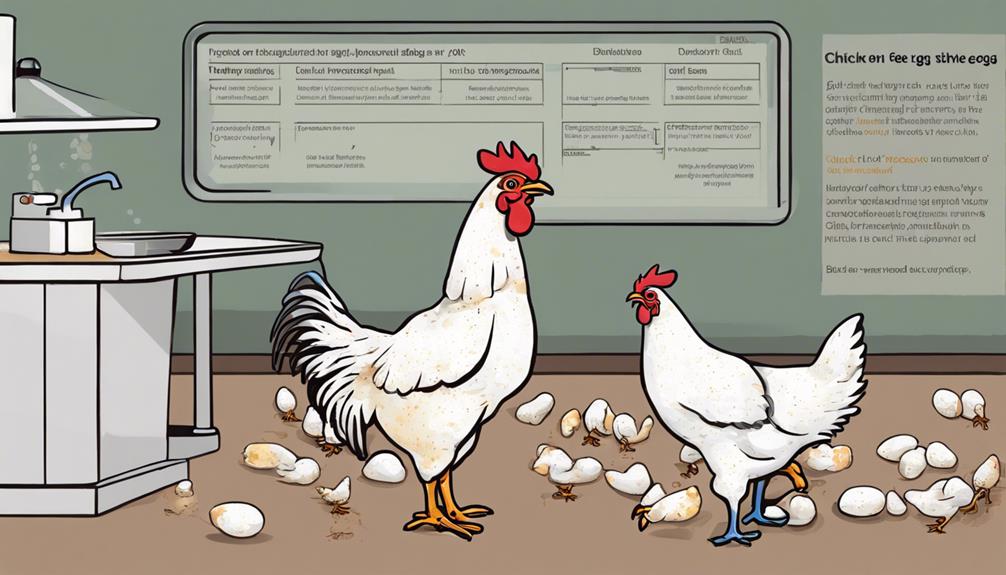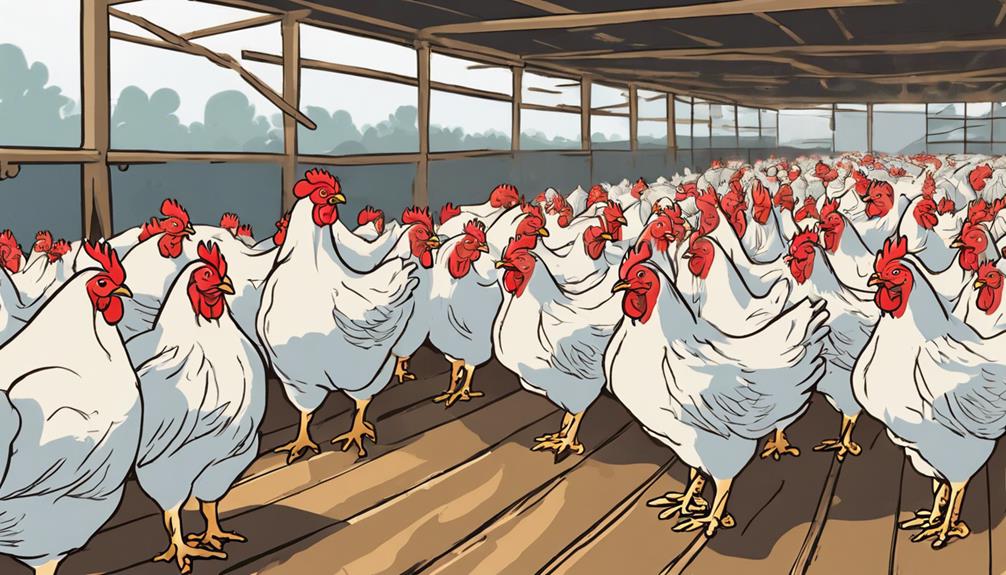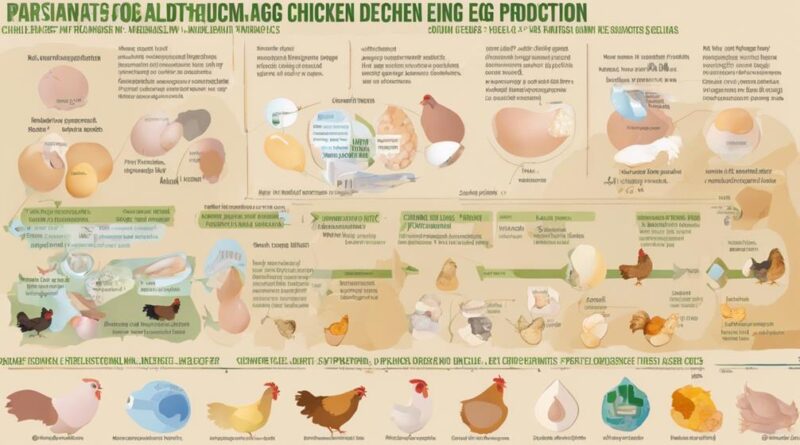Top 10 Health Issues Affecting Chicken Egg Production"
You might be surprised to learn about the multitude of health issues that can impact chicken egg production. From infectious bronchitis to Marek's disease, these conditions can significantly affect the quantity and quality of eggs produced. Understanding these challenges is crucial for the overall well-being of your flock and the profitability of your operation. Stay tuned to discover how these health issues can be managed and prevented to ensure a successful egg production process.
Infectious Bronchitis
Infectious bronchitis affects chickens' respiratory systems, causing significant economic losses in egg production. This respiratory infection is highly contagious and can spread rapidly within flocks. Infected chickens may exhibit symptoms such as coughing, sneezing, nasal discharge, and decreased egg production. The impact on egg quality is substantial, with affected hens laying eggs with thin shells, abnormal shapes, and decreased internal quality. These changes in egg quality not only affect marketability but also result in production losses due to lower hatchability rates.
Prevention strategies play a crucial role in managing infectious bronchitis in chicken flocks. Implementing strict biosecurity measures is essential to prevent the introduction of the virus to the flock. This includes limiting visitors, disinfecting equipment, and maintaining separate clothing and footwear for workers entering the chicken houses. Vaccination is another key component of prevention, with various vaccine strains available to provide protection against different viral variants. Timing and method of vaccination are critical to ensure optimal immunity in the flock.
Regular monitoring for early detection of infectious bronchitis is vital to implement control measures promptly. Working closely with a veterinarian to develop a comprehensive health management plan can help mitigate the impact of infectious bronchitis on egg production. By focusing on prevention and proactive management strategies, producers can safeguard their flocks and minimize economic losses associated with this respiratory infection.
Egg Peritonitis
Egg Peritonitis, a condition affecting chickens, involves the inflammation of the peritoneum, a membrane lining the abdominal cavity. This condition often arises when the oviduct becomes infected, causing egg material to enter the abdominal cavity instead of being laid normally. Symptoms of Egg Peritonitis include a decreased egg production rate, lethargy, weight loss, and abdominal swelling. Chickens affected by this condition may also exhibit signs of respiratory distress and depression.
Treatment for Egg Peritonitis typically involves antibiotic therapy to combat the infection. However, in severe cases, surgery may be necessary to remove the infected material from the abdominal cavity. Supportive care, such as providing a quiet and stress-free environment, is crucial for the recovery of chickens with Egg Peritonitis. It's important to consult a veterinarian for an accurate diagnosis and treatment plan tailored to the specific needs of the affected chickens.
To prevent Egg Peritonitis, it's essential to maintain good hygiene practices in the coop, ensuring that eggs are promptly collected to prevent the development of bacterial infections. Regular health checks and monitoring of egg production can help in early detection and treatment of any underlying issues that may lead to Egg Peritonitis.
Fowl Pox
Fowl Pox is a viral disease that commonly affects poultry, causing characteristic skin lesions and potentially impacting their overall health and productivity. The disease is transmitted through direct contact with infected birds or contaminated environments. Prevention strategies include vaccination, biosecurity measures to limit exposure, and controlling the presence of biting insects, which can act as vectors for the virus.
In terms of treatment options, there's no specific cure for Fowl Pox. Supportive care focusing on maintaining good nutrition, hydration, and minimizing stress can aid in the recovery of affected birds. Infected birds should be isolated to prevent further spread within the flock.
The impact of Fowl Pox on production can be significant. Affected birds may experience decreased egg production, poor egg quality, and slower growth rates. Additionally, the disease can lead to mortality in severe cases, further affecting overall productivity. These implications can result in economic losses for poultry producers due to decreased egg output and increased mortality rates.
Ectoparasites Infestation
Dealing with ectoparasites infestation in poultry requires prompt identification and targeted control measures to safeguard the health and productivity of the birds. Ectoparasites are external parasites that feed on the blood of chickens, leading to discomfort, stress, and potential health issues. Common ectoparasites affecting poultry include mites, lice, and fleas. These parasites not only impact the well-being of the birds but also pose a significant threat to egg quality and production rates.
To effectively combat ectoparasites, various treatment options and prevention strategies can be implemented. Treatment often involves the use of acaricides and insecticides specifically designed to target and eliminate these external parasites. Regularly inspecting the birds and their living environment is crucial for early detection and intervention. Additionally, implementing good biosecurity practices can help prevent the introduction and spread of ectoparasites within the flock.
The presence of ectoparasites can directly affect egg quality and production rates. Infestations can lead to decreased egg production, smaller egg sizes, and even lower hatchability rates. Furthermore, the stress caused by these parasites can result in reduced feed consumption and overall growth performance in chickens. Therefore, addressing ectoparasites promptly is essential for maintaining the health and productivity of the poultry flock.
Newcastle Disease
Newcastle Disease, a highly contagious viral infection, poses a significant threat to the overall health and productivity of poultry flocks. This disease is caused by the Avian Orthoavulavirus-1, formerly known as Avian Paramyxovirus-1. The virus affects the respiratory, nervous, and digestive systems of birds, leading to symptoms such as respiratory distress, greenish diarrhea, and nervous signs like twisting of the neck.
Prevention strategies play a crucial role in controlling Newcastle Disease outbreaks. Vaccination is a key preventive measure, with live and inactivated vaccines available to protect birds from the virus. Vaccination programs should be tailored to the specific needs of the poultry operation and implemented consistently to ensure optimal protection. Biosecurity measures are also essential to prevent the introduction and spread of the virus within flocks. This includes controlling access to poultry houses, disinfecting equipment, and monitoring visitors for compliance with biosecurity protocols.
In terms of treatment options, there's no specific antiviral treatment for Newcastle Disease. Supportive care, including providing birds with a stress-free environment, adequate nutrition, and clean water, is important to help affected birds recover. Quarantine measures should be implemented to prevent the spread of the virus to healthy birds. In severe cases, euthanasia of affected birds may be necessary to prevent further transmission of the disease. Early detection and prompt action are vital in managing Newcastle Disease outbreaks effectively.
Egg Drop Syndrome
Egg Drop Syndrome, occasionally occurring in poultry, primarily affects the egg production of laying hens. This syndrome is characterized by a sudden drop in egg production, soft-shelled or shell-less eggs, and a decrease in egg quality, leading to economic losses for poultry farmers. To combat Egg Drop Syndrome, implementing effective vaccination strategies is crucial. Vaccines targeting the causative agent, the adenovirus, have been developed to prevent and control outbreaks. Proper vaccination protocols, including timing and dosage, are essential to ensure maximum efficacy.
In addition to vaccination, specific management practices play a key role in preventing and managing Egg Drop Syndrome. Maintaining strict biosecurity measures, such as controlling access to the poultry farm and regularly disinfecting equipment, can help reduce the risk of introducing the virus to the flock. Monitoring the health status of the birds regularly and promptly isolating any sick individuals can prevent the spread of the disease within the flock.
Furthermore, optimizing the nutritional program of laying hens by providing a balanced diet rich in essential nutrients can support their immune system and overall health, potentially reducing the susceptibility to Egg Drop Syndrome. By combining appropriate vaccination strategies with stringent management practices, poultry producers can effectively mitigate the impact of Egg Drop Syndrome on egg production and safeguard the profitability of their operations.
Avian Leukosis

Avian Leukosis poses a significant threat to poultry health and egg production efficiency, necessitating proactive management strategies to control its impact. Avian leukosis, caused by the Avian Leukosis Virus (ALV), is a neoplastic disease affecting chickens worldwide. The virus primarily targets the immune system, leading to various tumors in multiple organs, including the liver, spleen, bursa of Fabricius, and the kidneys.
Chickens with a genetic predisposition are more susceptible to avian leukosis. The transmission of ALV commonly occurs vertically through the egg, but horizontal transmission can also happen through contaminated environments. Infected birds may show clinical signs such as weight loss, decreased egg production, pale combs, and increased mortality rates.
To manage avian leukosis effectively, strict biosecurity measures should be implemented to prevent the introduction and spread of the virus within the flock. Testing breeding stock for ALV and implementing vaccination programs can help reduce the incidence of the disease. Culling infected birds and maintaining a clean environment are crucial steps in controlling avian leukosis and minimizing its impact on egg production.
Early detection through regular monitoring and testing is essential to prevent economic losses associated with decreased egg production and increased mortality rates caused by avian leukosis.
Marek's Disease
Marek's Disease, a highly contagious viral illness affecting poultry, particularly chickens, presents a significant challenge to poultry farmers due to its rapid spread and detrimental effects on bird health. The disease is caused by the Marek's disease virus, a type of herpesvirus.
Here are some key points to consider when dealing with Marek's Disease:
- Vaccination Strategies: Vaccination is the most effective method to control Marek's Disease. Chicks can be vaccinated either in ovo (in the egg) or shortly after hatching to provide early protection against the virus.
- Genetic Resistance: Selecting for genetic resistance in breeding programs is another vital approach. Breeding resistant chicken lines can help reduce the incidence and severity of Marek's Disease within flocks.
- Biosecurity Measures: Implementing strict biosecurity measures is crucial to prevent the introduction and spread of the Marek's disease virus. This includes controlling wild bird contact, limiting visitor access, and disinfecting equipment.
- Regular Monitoring: Regularly monitoring flock health and conducting diagnostic tests can aid in early detection of Marek's Disease. Early identification allows for prompt intervention and containment of the virus within the flock.
Infectious Coryza

What're the key characteristics of Infectious Coryza in poultry production? Infectious Coryza is a bacterial disease primarily affecting chickens, caused by Avibacterium paragallinarum. This disease is characterized by facial swelling, inflammation of the sinuses, and a foul-smelling nasal discharge in affected birds. The bacteria are transmitted through direct contact with infected birds, contaminated feed or water, and can survive for extended periods in the environment.
In terms of treatment options, antibiotics such as tetracyclines or sulfonamides can be administered to infected flocks. However, it's crucial to consult with a veterinarian to determine the most effective treatment plan. Prevention strategies for Infectious Coryza include strict biosecurity measures, isolating sick birds, and proper sanitation protocols to prevent the spread of the disease within the flock.
The economic impact of Infectious Coryza can be significant due to decreased egg production, increased mortality rates, and the costs associated with treatment and prevention. Vaccination protocols can be implemented to reduce the prevalence of the disease in poultry flocks. Vaccines should be administered according to recommended schedules and guidelines to ensure optimal protection against Infectious Coryza. Proper management practices and regular health monitoring are essential components in controlling the spread of this disease within a poultry operation.
Mycoplasma Gallisepticum
Mycoplasma Gallisepticum causes respiratory disease in chickens, affecting the respiratory tract and leading to various symptoms such as conjunctivitis and nasal discharge. This bacterium can significantly impact egg production in poultry farms.
Here are some key points to consider:
- Treatment Options: Antibiotics such as tetracyclines and macrolides are commonly used to treat Mycoplasma Gallisepticum infections. However, it's essential to consult with a veterinarian to determine the most effective treatment plan for your flock.
- Prevention Strategies: Implementing biosecurity measures is crucial in preventing the spread of Mycoplasma Gallisepticum within a poultry operation. Isolating sick birds, disinfecting equipment, and controlling wild bird access can help reduce the risk of infection.
- Economic Impact: Mycoplasma Gallisepticum outbreaks can lead to decreased egg production, increased mortality rates, and higher treatment costs, resulting in financial losses for poultry producers.
- Industry Measures: The poultry industry often enforces strict testing and monitoring protocols to detect and control Mycoplasma Gallisepticum infections. Regular screenings, vaccination programs, and proper hygiene practices are essential for maintaining the health of chicken flocks and ensuring optimal egg production.
Frequently Asked Questions
Can Egg Production Be Affected by Stress in Chickens?
When chickens experience stress, their egg production can be negatively impacted. Stress management is crucial for maintaining optimal egg quality.
Providing behavioral enrichment can help reduce stress levels in chickens, leading to improved egg production. By creating a stimulating environment, you can promote healthier and more consistent egg-laying patterns.
How Can Farmers Prevent Eggshell Abnormalities in Hens?
To prevent eggshell abnormalities in hens, you should focus on dietary supplements to address calcium deficiency.
Incorporate calcium-rich feed and ensure hens have access to oyster shells or grit.
Consider genetics and breeding practices to select hens with strong eggshell traits.
Monitor calcium levels in the diet closely to maintain optimal eggshell quality.
Are There Any Natural Remedies for Respiratory Infections in Chickens?
When dealing with respiratory infections in chickens, natural remedies like herbal supplements can be effective. These remedies can help boost the immune system and alleviate symptoms.
Incorporating herbs such as oregano, garlic, and thyme into their diet can provide antibacterial and antiviral properties.
Additionally, proper ventilation and hygiene practices are crucial in preventing the spread of respiratory infections among your flock.
Regular monitoring and prompt action are key in maintaining your chickens' respiratory health.
What Measures Can Be Taken to Control Mites and Lice Infestations?
To control mites and lice infestations on your chicken farm, implement thorough pest control measures. Regularly clean and disinfect coops, nests, and surrounding areas to prevent infestations.
Use approved pesticides and insecticides specifically designed for poultry to manage the infestation effectively. Monitor your flock regularly for signs of pests and take immediate action to address any issues.
Consistent pest control practices are essential for maintaining a healthy environment for your chickens.
Is There a Correlation Between Nutrition and Egg Quality in Chickens?
When it comes to the correlation between nutrition and egg quality in chickens, dietary supplements play a crucial role. Quality feed with proper nutrients can enhance egg production and overall egg quality.
Genetic factors also influence the egg quality traits in chickens. By providing a balanced diet rich in essential nutrients and considering genetic factors, you can positively impact the quality of eggs produced by your chickens.
Conclusion
In conclusion, the top 10 health issues affecting chicken egg production require a multifaceted approach for prevention and control.
By implementing strict biosecurity measures, utilizing vaccination strategies, and selecting for genetic resistance, producers can effectively mitigate the impact of respiratory diseases, viral infections, and parasitic infestations.
Treatment options, such as antibiotic therapy and supportive care, must be tailored to reduce economic losses, control disease spread, and uphold egg quality standards through proper management practices.
